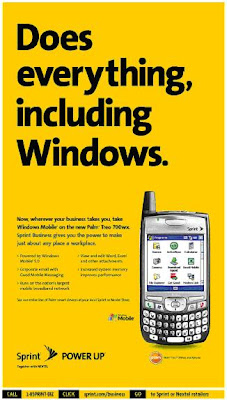Introducing a sleek and sexy phone. What do you mean your phone can’t send and receive emails? A Paris Hilton signature series. I take great pictures with my 1.3 megapixel camera phone. We have the strongest network. Show your spirit, and get your NASCAR branded phone today. My phone can stream video, can yours?
These are a sampling of the phrases consumers are likely to hear or read about in cell phone advertising.
Because the mobile space is extremely crowded, it is necessary to differentiate core functionality between phones, hence the proliferation of ads focused on device and service offerings. However, it is also important for ads to transcend this one-dimensional messaging approach, and demonstrate how the phone’s advanced features can be utilized by the phone’s owner. It is assumed that consumers connect more uniquely with advertisements in which the person using the phone is someone they are like or aspire to be, thus the explosion of “cool” lifestyle ads.
Although it is seemingly logical to market a cell phone in these ways, each direction is flawed. To understand why, first take a look at these ads.



These ads are not inherently displeasing or jarring, and consequently, lack originality. It would be easy to switch around the logos, and not know who promised what. It is here that the major problems become apparent.
First, lifestyle advertising has poorly reflects or connects with its intended target audience. Secondly, pure product functionality advertising ends up commoditizing a product.
First, lifestyle advertising has poorly reflects or connects with its intended target audience. Secondly, pure product functionality advertising ends up commoditizing a product.
Great advertising that gets people to buy a product or service, even beyond what they justify as a fair price, hinges on a delicate emotional balance between usability and sociological approval. Whether a consumer will or will not buy a certain phone invariably depends on whether said phone is psychologically easy, not functionally, to use. Most cell phones on the market have the same functionality. As a result, wireless carriers and manufacturers have moved to competitive differentiators based on style, “wow” factor, and other seemingly meaningless distinctions.
The question cell phone companies and manufacturers need to ask themselves is what type of message are they trying to communicate with their target audiences. Do they want to brand themselves as a fashion icon? Do they want their audiences to think of their phones as “workhorses?” These are questions they must think about more intently then they have before.
Right now, there is little differentiation between the brands of most carriers and manufacturers. To give some examples, Verizon is coverage, Nokia is fashion, Cingular is the network and latest phones, Research in Motion is business, T-Mobile is price, Palm is ease of use, and LG is about entertainment. These attributes are too broad, shallow, and can easily be lost if a competitor chooses to enter that territory.
It is time this industry considers a new strategy for marketing their products.
The question cell phone companies and manufacturers need to ask themselves is what type of message are they trying to communicate with their target audiences. Do they want to brand themselves as a fashion icon? Do they want their audiences to think of their phones as “workhorses?” These are questions they must think about more intently then they have before.
Right now, there is little differentiation between the brands of most carriers and manufacturers. To give some examples, Verizon is coverage, Nokia is fashion, Cingular is the network and latest phones, Research in Motion is business, T-Mobile is price, Palm is ease of use, and LG is about entertainment. These attributes are too broad, shallow, and can easily be lost if a competitor chooses to enter that territory.
It is time this industry considers a new strategy for marketing their products.



No comments:
Post a Comment